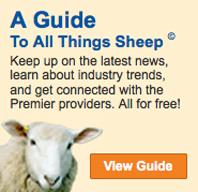
POSITION AVAILABLE
Growing mail-order agribusiness is seeking…
Premier is looking for a full-time farmhand with sheep and farm machinery skills. We have 1000 commercial ewes which we lamb inside from mid Dec. onwards. If you are interested send details to jpotratz@premier1supplies.com.
QUICK LAMBING JUGS
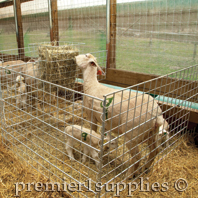
A typical lambing jug at Premier. Jugs allow the ewe to form a strong bond with her offspring in a controlled environment.
Lambing jugs using Premier's Wire Panels
Select height (PowerBilt® panels 36" or 48" tall or our Standard panels 40" ) according to your animals’ behavior (wild vs relaxed, athletic vs calm) and your preferences (tall vs short).
We use connector hinges or braided nylon cord to tie jugs together and snap clips as latches.
HEAVY DUTY PEN FEEDERS
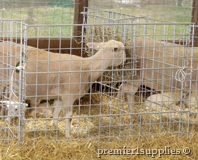
X-Tuff Hay Feeder in use in a lambing jug (made from Premier panels). It keeps hay above the ground (reducing waste) and is strong enough for adult ewes.
Grain & Hay Feeders
| • |
Less waste |
| • |
More durable than plastic |
| • |
Hot-dip galvanized |
Hay prices are now very high. It’s essential to reduce waste. These feeders do just that. The small openings on the sides prevent adult sheep/goats from pulling out more than they can chew. Holes on the bottom of the hay feeder allow lambs/kids to eat with mom.
Metal feeders, unlike plastic ones, will not crack, fade or deteriorate over time. And because they are heavier than plastic, they are not easily knocked around.
These have become the preferred single-pen feeders in Premier’s barns. And we cringe less when we feed quality hay to our ewes—because very little hay is wasted. Highly recommended.
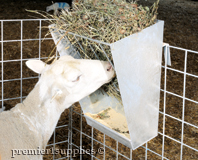
Grain and/or Hay Feeder feed hay and supplement with the same feeder.
|
 |
 |
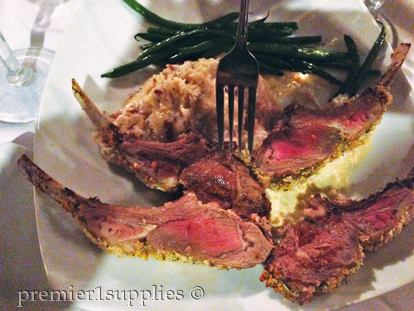
Help the Lamb Industry—
Become a Lamb Critic
Send us reviews with photos of your lamb eating experiences. We'll compile them and present them to our newsletter readers.
Why do this?
| 1. |
Because sharing experiences can be fun. |
| 2. |
To help lamb producers, packers and industry leaders to know that which they are doing well—and not so well. (We will forward them to them.)
|
| 3. |
To stimulate restaurant chefs and stores to offer lamb by providing them free exposure and evidence that people care and notice when they offer lamb. |
How to do it?
Each time you eat lamb in a restaurant or cook lamb that you purchased in a store, tell us about it in an email. If possible take a photo of lamb dish or lamb on the store shelf. Send email and photo to jputnam@premier1supplies.com.
If possible, include:
| • |
Date of photos. |
| • |
Name of restaurant, store or event. |
| • |
Location (city & state is enough). |
| • |
Name of entree plus any useful copy from the menu. |
| • |
Source of lamb. (Ask the waiter). State, brand or country. |
| • |
Cost of entree or cost/lb if purchased at a store. |
| • |
Your evaluation and comments. |
| • |
Your name for our verification purposes. We won't include it in our newsletter. |
What will we do with your reviews?
| 1. |
Publish them in our next newsletter. |
| 2. |
Include them in our online sheep guide.
|
| 3. |
Forward them to the American Lamb Board. |
| 4. |
If we receive enough reviews, we'll prepare an interactive map of the US with the locations on it. |
I'll provide some samples from my recent trips:
Review 001
| • |
Jan. 2014 |
| • |
Charleston, SC. |
| • |
Saffire restaurant in Marriott hotel that hosted the national sheep convention. |
| • |
Was told the lamb was from Detroit so I assume US lamb from Wolverine - a lamb packer. |
| • |
Tenderloin that was excellent in flavor. Young lamb (based on size of muscle fibers) Tender. Not expensive. |
| • |
Not that expensive. |
| • |
Only negative... it wasn't on the menu two nights later! |
Review 002
| • |
Jan. 2014 |
| • |
Charleston, SC. |
| • |
Saffire restaurant in Marriott hotel that hosted the national sheep convention. |
| • |
Lamb chop. |
| • |
50% or more fat. A definite negative. |
| • |
Assume it was the same Detroit source but did not ask. Probably should have. |
| • |
Not good value at all. |
Review 003
| • |
Jan. 2014 |
| • |
Charleston, SC. |
| • |
McCrady's— recommended restaurant in historic section of Charleston. |
| • |
Cost of entree was more than $30. |
| • |
Lamb loin. Unusual in several respects. Wish now I had taken a photo of it. Sat on the plate as a 3" x 4" rectangle about 2.5" high. The upper 0.75" was pure lamb fat. Fat was easy to remove with a knife and fork but between the fat and the muscle was a thin, but tough, white layer of sinew that I had to cut away from the meat itself. |
| • |
Was told the lamb was from a local South Carolina flock. |
| • |
Meat had good flavor—but it was a little tough. Yes, I know that a cook/chef can make lamb better or worse—but this was one of the best restaurants in Charleston. |
Review 004
| • |
Jan. 2014 |
| • |
Savannah, GA |
| • |
NobleFare—a white tablecloth restaurant. |
| • |
Lamb shank. |
| • |
Source - Grove Farm in CO (a Superior Farms brand). |
| • |
Cost for entree: Over $30. |
| • |
Notable for:
| 1. |
It's size (the biggest I've ever seen). 50% larger than my fist and I have large hands. This lamb had lived longer than most lambs and grown large before it was slaughtered. |
| 2. |
It's tenderness. Literally fell off the bone.
|
| 3. |
Flavor. First class. This chef knew what he/she was doing with lamb of this size and age. |
| 4. |
Enough meat for 2 men my size (and age) unless they're doing hard physical labor. |
|
Review 005
| • |
Jan. 2014 |
| • |
Savannah, GA. |
| • |
17hundred90 restaurant. Very nice place. Great atmosphere. |
| • |
Lamb cutlets. |
| • |
Source: New Zealand. |
| • |
Surprised by the thin, poorly shaped loin eye. |
| • |
Not much flavor. |
| • |
Also not that tender either. |
| • |
Would not order these again there. But it cheered me to see that the Kiwi's don't always get it right! |
A final thought on lamb quality
The American Lamb Board recently hired 2 people to conduct a survey of producers that direct market their lamb. Their report to the Lamb Board is due soon.
I happened to meet the producers who conducted the survey at the Charleston event. I urged them to ask the Lamb Board to provide $$ for further education to producers about ways to improve (or not) the potential eating quality of the lamb they produce. By this I mean the optimal genetics, feeding systems, handling and transport prior to slaughter as well as examples of "what not to do".
Henry Zerby, the lamb meat expert at Ohio State, happened to be sitting with us. He suggested that it be done by a series of short YouTube videos—in recognition that most of us have neither the time nor the ability to mentally absorb multiple points in one "sitting".
If you want the Lamb Board to expend $$ to do this, I encourage you to contact the American Lamb Board yourself by email and tell them so. They will listen. Contact info@americanlambboard.org
Thanks for "listening".
Stan Potratz
EXTENSION NEWS
Lambing Jugs
By Penn State Extension
When lambing inside, be sure to have enough lambing pens or jugs to accommodate the size of your flock.
Be sure to have enough room to prevent overcrowding. This is very important. You should allow approximately 16 square feet for each ewe, but plan for a larger area if you have large sized ewes. There should be plenty of ventilation, but the area should be free of drafts. There should be enough air movement to allow for air-exchange. Your sheep should never be closely housed.
You want to keep the jugs dry and well bedded. You want to use straw or another suitable bedding material. Sawdust is not considered a suitable material due to contamination of the ewe at lambing. Your jugs should be made of moveable panels. These pens can be set up and taken down as needed. They need to be approximately 3 feet high and 4 feet long.
You should expect the first lambs to arrive a few days prior to the full 21 weeks. The ewes that are close to lambing should be penned so that they can be watched carefully. Be sure to not overcrowd. Many lambs have been lost when the ewe crushes the first born while trying to give birth to the second one.
Read More »
COLD WEATHER LAMBING
Shed Lambing
By Micky Burch
For many sheep producers, lambing has already started or is right around the corner. Be it commercial producers aiming for the high of the Easter market, club lamb producers setting their sights on summer shows or seedstock sheep folks raising rams that are mature enough to be turned out with ewes for the fall breeding season, there are several scenarios in which sheep producers utilize the time-tested practice of shed lambing.
According to the website sheep101.info, a lambing system specifies when lambing will occur (what season or months), how often a ewe will lamb (annual vs. accelerated), and how and where lambing will take place (shed vs. pasture). While there’s more than one way to raise sheep, producers should match the lambing system to their goals, objectives, resources and market demand.
Shed lambing is simply lambing indoors and is a very common system for lambing. It provides the ewe and her lamb(s) (also known as sheep “families”) protection from the elements as well as from predators. It also allows for earlier lambing during times of cold or inclement weather.
Read More »
|
|